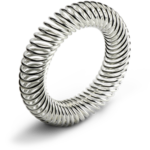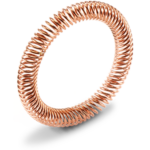The canted coil spring is a multi-purpose component coiled from metal wire and often plated with a variety of metals. Widely known for its use as an energizing element in fluid seals, the spring has mechanical and electrical properties that enable it to mate parts, manage current, and protect electronics from electromagnetic interference (EMI). If simple, lightweight, power-efficient designs are your goal, a canted coil spring may be worth considering.
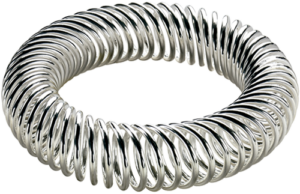
What does a canted coil spring do?
- Mechanically connects
- Conducts electrical current in high shock/vibration
- Shields against EMI/RFI
- Centers/aligns parts
Canted Coil Spring Advantages
Since it generates a near constant spring force vs. deflection range, the canted coil spring can often deliver longer service life than similar components. As hardware surfaces wear, the spring’s individual coils deflect independently to compensate for angular misalignment and irregularities. This translates to more reliable conductivity in electrical applications, and higher cycle counts in mechanical applications. The spring also reduces contamination by incorporating chemically compatible, wear-resistant wire base materials and platings. This lessens the possibility of premature degradation, and minimizes the potential for shedding.
Mechanical Spring Advantages
As a mechanical fastening component, the canted coil spring latches, locks, and holds. With precise adjustments to the angle of its coils, insertion and removal forces can be controlled from less than 1 lb to 10,000+ lb. Unlike ball detents, snap rings, molded c-clamps, quick connects, o-rings and other fastener types, the canted coil spring resists fatigue and compression set, so it can maintain consistent, repeatable forces over thousands of cycles.
Electrical Spring Advantages
In electrical conducting and EMI/RFI shielding applications, the spring’s individual coils provide multi-point contact, and they compensate for mating surface irregularities and misalignment. As an electrical contact component, the canted coil spring has a high degree of power density; it can manage more current in less space than similar technologies, while minimizing heat rise.
Canted Coil Spring Design
The most visible difference between a canted coil spring and other spring types is its cross-section, which is elliptical or oval, not circular. Key design characteristics of the spring are its wire diameter (WD), coil height (CH), coil width (CW), coil spacing, and coil angle. Each of these can be precisely adjusted to influence force, electrical contact resistance, and other properties. The orientation of a spring’s coils in relation to the centerline determines whether it is axial or radial. Compression force for a radial canted coil spring is along the radius of the arc or ring, perpendicular to the centerline. Compression force for an axial canted coil spring is along the axis of the arc or ring, parallel to the centerline.
Radial Spring
Compression force for a radial canted coil spring is along the radius of the arc or ring, perpendicular to the centerline.
Axial Spring
Compression force for an axial canted coil spring is along the axis of the arc or ring, parallel to the centerline.
Radial Spring Deflection
Canted Coil Spring Mounting & Grooves
The canted coil spring is often used in a housing-mounted configuration, but it can also be mounted on a piston or shaft.
Typical Canted Coil Spring-In-Housing Configuration
The function and performance of the spring are also highly dependent upon the design of the groove in which it is mounted. Some groove configurations optimize electrical contact of mated parts, while others offer measured mechanical resistance (latching) in both directions or restrict movement to a single direction (locking).
Although certain spring groove designs are better suited for electrical conducting or mechanical fastening, flat, rounded, tapered, and “V” bottom grooves can be found across the service and application spectrum.
How a Canted Coil Spring Works
Once installed into a groove—a state known as initial spring force deflection—a canted coil spring’s load remains relatively constant up to maximum deflection. This is the point at which the individual coils touch and no further deflection is possible.

The spring force acting on the contact surfaces remains within the working spring force deflection range while providing only the required force to affect mechanical retention or electrical conductivity. Other components, such as O-rings and V-springs, develop higher initial forces, which are proportional to deflection. This results in higher insertion/breakaway forces, and reduced cycle life.
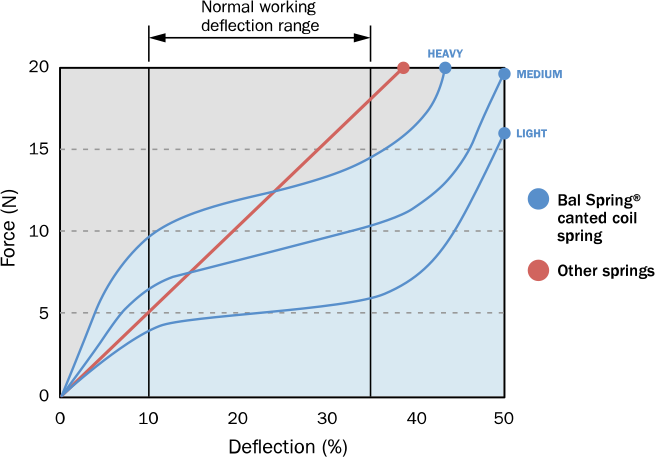
In addition to physical/mechanical forces, design of a canted coil spring used in electrical conducting, EMI shielding, and grounding applications must give special consideration to wire material, plating material, and plating thickness. Plating, the application of highly conductive material over the base wire metal, significantly increases the electrical performance of the spring.
Canted Coil Spring Service Types
The mechanical and electrical capabilities of the canted coil spring are not exclusive. For example, the spring can be used to mechanically latch machine components and protect internal electronics from EMI/RFI. It can also be used to lock parts together while providing an electrical ground. The spring’s ability to perform as many as three functions at once can support lighter, designs that are easier to maintain.
Canted Coil Spring Lengths
While the canted coil spring is most widely recognized in its welded ring configuration, it is also commonly used in unwelded lengths. These are especially well-suited for EMI shielding applications that require linear installation in simple or intricate patterns. Spring lengths can be plated with silver, gold, and other highly conductive metals to enhance electrical performance. In some applications, the canted coil spring length offers better shielding performance than conductive elastomers, fabrics, foams, and mesh, because its coils resist compression set and maintain consistent, multi-point contact in shock and vibration.
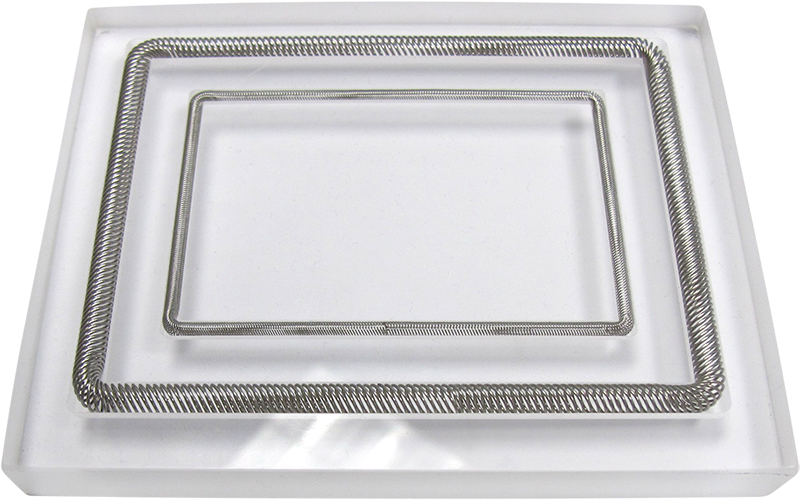
Canted Coil Spring Wire Materials
Media resistance, galvanic compatibility—even biocompatibility—can be key factors impacting the selection of canted coil spring wire materials. Copper alloy and stainless steel are popular base wire materials because they combine good electrical and mechanical properties, and they’re relatively easy to source and manufacture. Copper alloy is conductive enough to be used on its own (unplated) in many applications, but stainless steel may require plating for applications where a higher level of electrical performance is desired. Mechanically, a canted coil spring made from stainless steel wire will have a higher force-per-unit compression than one made from copper alloy. The canted coil spring can be made from a range of base wire materials, including:
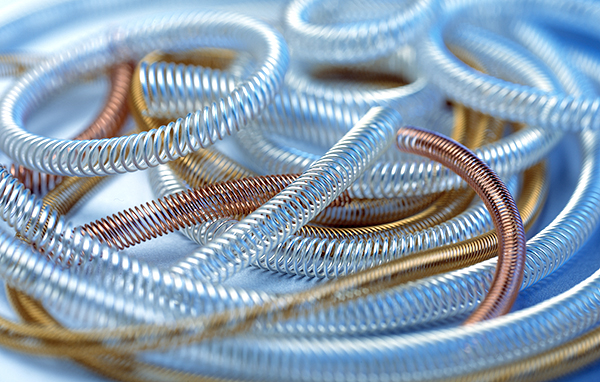
- Stainless Steel
- MP35N®
- Platinum Iridium
- Titanium
- Elgiloy
- Hastelloy®
- Inconel®
- Beryllium-Copper
- Zirconium-Copper
Canted Coil Spring Plating
For applications that require higher levels electrical conductivity, wear prevention, and/or corrosion resistance, a canted coil spring may be plated. In this process, the spring’s base wire material is coated with a thin layer of another, typically more conductive metal. This improves electrical performance while allowing for the use of base wire materials that meet mechanical requirements, such as interface and retention force, temperature resistance, and fatigue resistance, among others. Plated wire significantly outperforms non-plated wire in environments with wide temperature fluctuations and chemically aggressive media.
Different spring plating types are chosen based on their conductivity, material compatibility, galvanic compatibility, and other properties. Plating is usually applied to the entire spring, so that there are no areas of exposed based material. Optimum plating thickness varies by application, with some requiring >5 µm and others up to 20 µm.
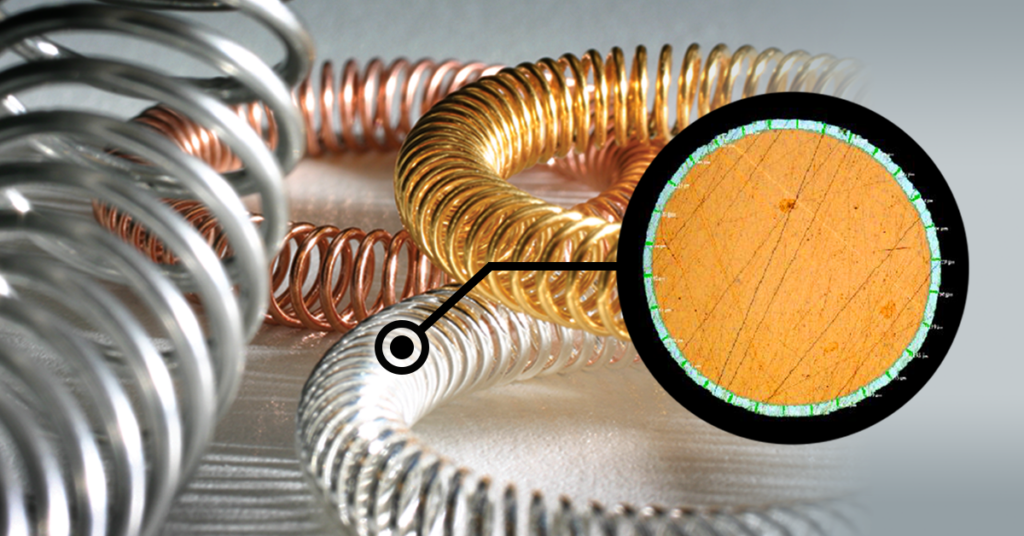
Typical Canted Coil Spring Plating Materials
- Gold
- Silver
- Nickel
- Tin
Canted Coil Spring Applications
A canted coil spring can be an ideal choice for operating environments with strict size restrictions, challenging electrical requirements, wide temperature fluctuations, and aggressive media. It can support design simplification and lightweighting, improve power efficiency, and increase uptime in a wide range of industries and applications, including:






Choosing The Right Canted Coil Spring
Whether it’s more repeatable, consistent fastening, cooler conducting, better protection against EMI, or a combination of all three, the canted coil spring can offer many advantages over similar components. To learn how our Bal Spring® canted coil spring can help you meet your engineering challenges, select an application type below.
